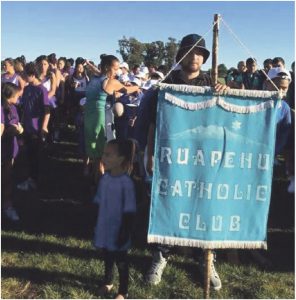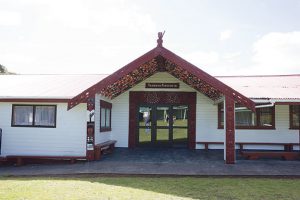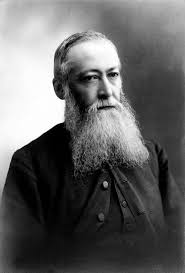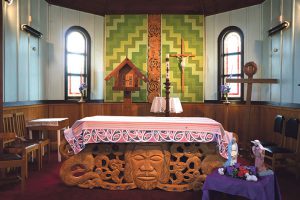What is the most important thing in the world?
It is the people, the people, the people.
To celebrate Te Reo Māori Language Week 11–17 September 2017, WelCom featured some of the Catholic Māori communities within the diocese.
The Māori Mission
Pā Gerard Burns
The first Catholic priests in Aotearoa New Zealand came to evangelise Māori. This was the mission of Bishop Pompallier and the Marist priests and brothers that came with him in 1838 and the following years. Initially the work among the European settler community was secondary.
As the number of settlers grew rapidly from 1840, eventually clergy were drawn away to pastoral care of the European Catholic community. Pastoral care for Māori began to take second place as they became a minority group and following the Land Wars of the 1860s were looked upon with suspicion.
Land confiscations and sales meant that European farms and towns came to occupy places where Māori had lived, hunted and fished. Pākehā and Māori became more separated in the areas in which they lived. Pastoral work among Māori required priests and religious who could speak Māori, understand their ways of living and thinking and be prepared to be ‘marginal’ among a marginalised people.
In 1850 Catholic New Zealand split into two dioceses – Auckland and Wellington. The latter covered everything south of Tūrangi to Stewart Island. In the Wellington area Marist priests and the Sisters of Compassion carried on the pastoral work including the present Palmerston North diocese. The priests were mostly French, even when reinforcements began to arrive from Ireland.
The methodology of the ‘Māori Mission’ was for the priests and sisters to visit Māori in their homes and marae. Masses and other sacraments would frequently be celebrated in these places and occasionally in churches. There were some places where the presence of the Church was stronger among Māori. It is largely in these areas that Mass in Māori has continued to be celebrated monthly.
Some of those places are in parts of Taranaki (Normanby, Waitara), Whanganui river area, Hawkes Bay (Wairoa and Pakipaki), Levin, Otaki, Kuku, Te Ore Ore and Kaikōura.
When Māori began to move to the cities in large numbers following WWII, the urban Mass centres grew – Te Kainga in Wellington and Te Ngākau Tapu parish, Porirua. In some places for lack of clergy and diminishing attendance some regular centres of Mass in Māori have ceased.
Monsignor Pā Gerard Burns is Vicar for Māori and Vicar General for the Archdiocese of Wellington.
Māori Eucharistic Communities
In the Palmerston North diocese, Māori Eucharistic communities include Kaiwhaiki, Hiruhārama and Rānana on the Whanganui River, Maungārongo marae in Ohakune and St Joseph at Taiuru marae. The two Māori secondary boarding schools, Hāto Pāora College and St Joseph’s Māori Girls’ College, are also in the diocese. Hāto Pētera-Hāto Paora at Kauwhata marae and Kakāriki Hāto Hōhepa at Te Hiiri marae are both in Fielding. Paki Paki in Hastings has weekly Miha at The Immaculate Conception Church and a local Trust is restoring the historic church. Māhia, St Mary’s in Taradale and St Thomas More are in the Napier Pastoral area. Ngā Pekanga Catholic Māori Society is based in Waitara.
Many local clubs also participate in religious quiz, sacred choir, kapahaka and sports competitions at the national annual Hui Aranga (Easter gathering). The first Hui Aranga was held in 1946 in Ōtaki.
Kaiwhaiki was the first Catholic mission on the Whanganui River in 1852 and today, Sr Makareta Tawaroa rsj is kaitiaki. At Maungārongo, Marists still serve the Māori community and since 1981, monthly Mass has been said in the chapel, Te Kingi o te Maungārongo.
Hoani Pāpita (John the Baptist)
Teoiroa Te Amo Joyce Luke
Hoani Pāpita is a Māori Eucharistic community in Normanby, South Taranaki.
In 1879, Fr Christophe Soulas sm arrived in New Zealand from France. From 1903 to 1920, he devoted himself entirely to spreading the faith among Taranaki Māori and was based at Okato. He was called ‘Hoani Pāpita’ by Māori. Fr Soulas and the Venerable Suzanne Aubert were friends of Rure (Te Manihera Keremeneta, 1864–1959).
The Māori Mission was established in Normanby in 1945. Fr T Gordon Kerins sm (Gordie) worked there from 1945–1947. Fr Francis Wall sm, known as Werahiko by local Māori, joined him in 1946–1952. Fr Wall received a CBE in 1974 and the Queen’s Medal in 1977 for his efforts for the Church and New Zealand society.
In 1949, a full ceremonial pōwhiri was given for Archbishop McKeefry at Ngārongo marae (also known as Ketemarae marae) by the principal hapū of the area, Araukuku of Ngāti Ruanui. Today, Araukuku Catholic Māori Club continues to take part in the annual Hui Aranga (Easter Gathering).
In 1964, the Archbishop opened and blessed Hoani Pāpita, the new Mission Hall, which had been built with volunteer labour. Today, Mass is celebrated on the first Sunday of the month. Catechism classes for tamariki, baptisms, confirmations and marriages take place and the community participates in parish Masses at St Joseph’s, Hawera and Sacred Heart, Manaia.
Three Papal Award recipients from Hoani Pāpita are Polly Edwards (deceased), Ray Edwards and Henare Ngaia. Mahuru Robinson is a representative on the school board and I am on the parish committee. Hoani Pāpita has its own Catholic Māori Council, which deals with all the business pertaining to our beloved Hoani Pāpita.
Tawhiti a Maru, Te Wairoa
Richard Puanaki
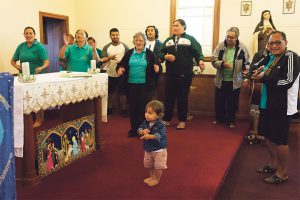

Richard Puanaki (far right) and whānau during their annual Hikoi to the Carmelite Sisters in Auckland, January 2017.
The three-fold community of faith in Te Wairoa of St Peter’s Parish, St Joseph’s School and Tawhiti a Maru Marae is one of the earliest Catholic communities in Aotearoa New Zealand. The Catholic Māori community are active in their faith commitment and participation.
The Catholic Māori community at Tawhiti a Maru Marae is made up of St Theresa’s Church, the church hall and the wharepuni (guest house). Miha Māori is celebrated on the first and third Sunday of each month. On the fifth Sunday of a month, Miha is celebrated in St Peter’s Catholic Church in town across the river.
In Wairoa, two initiatives will enhance Māori Language Week in 2017. The Wairoa Town Council has made an official commitment to make the town bilingual by 2040. Wairoa is the first town or city in New Zealand to make such a commitment for te reo Māori. Iwi and hapu are engaging with government to enhance their cultural and economic future. Together, these two initiatives will give direction to the town and for future planning.
He Rauemi Katorika Māori – Catholic Māori Resources
Deacon Danny Karatea-Goddard, Tūranga Māori
The following publications are available on request.
Resources for Miha Māori – Mass
Miha Setting A Mass setting in te reo Māori by Richard Puanaki. Email: [email protected]
Ko Ngā Karakia o Te Miha me Ngā Hīmene A Mass book in Māori and English by Pā M Ryan. Includes the Mass, Hymns and Devotional Prayers. Contact Pā Ryan, 7 Westminster Rd, Mt Eden, Auckland; ph (09) 630-9554; email [email protected]
Te Miha Māori – Mass Prayers for Priests The CD in te reo Māori is collated by the late Pā Henare Tate; and Danny Karatea-Goddard. Email [email protected]
Te Miha Māori – Weekly Sunday Readings Mass Readings, Gospel, Collect, Antiphons and Homily notes. Contact: Pā M Ryan (see above).
Te Miha Māori – Sunday Readings Adapted from Pā Ryan’s Weekly Sunday Mass Readings. Email: Rangimoeroa Waikari-Panapa at [email protected] or visit the Māori Vicariate page on the Archdiocesan website www.wn.catholic.org.nz [tinyurl.com/Miha-Readings].
Ritenga Tangihanga – Funeral Rites He Tikanga Karakia me Ngā Hīmene mō te Tangihanga me te Nehunga – Funeral Rites, Hymns and Readings, by Pā PM Ryan. Contact: Pā M Ryan (see above).
Theology
He Puna Iti i te Ao Mārama – A Little Spring into the World of Light This book, by the late Pā Henare Tate, is about Māori theology based on Māori culture and history. Contact: Libro International, 78 West Coast Rd, Oratia, Auckland 0604. www.librointernational.com
General
Kaupapa Māori – Māori Dimension This resource, prepared by Danny Karatea-Goddard for the National Liturgy Office, provides key markers for the use of Māori text, images, music and perspectives, to help with the Māori dimension in liturgy for the Catholic Church in Aotearoa-New Zealand. Contact: Louise Campbell, National Liturgy Office, email [email protected]
He Rārangi Papa Kupu Katorika – A Catholic Word List A glossary of Māori-English and English-Māori word lists and phrases specific to their use in the Catholic Church Aotearoa-New Zealand, prepared by Danny Karatea-Goddard. Available online at: pndiocese.org.nz/maori/glossary
Ko Ngā Karakia o ia Rā – Prayers In Common Use A booklet of common-use prayers translated into te reo Māori, by Bishop Peter Cullinane and the late Pā Henare Tate. Available from: Pleroma Christian Supplies, free phone: 0508 988 988, extn 4; email [email protected]
Published in WelCom September 2017
Catholic bishops pray for soul of Māori King
Māori
Published on 5th Oct, 2024
The Māori King, Tuheitia Paki, crowned Te Arikinui Kiingi Tuheitia, died on 30 August 2024 [..]
Māori language festival draws thousands to Heretaunga
Māori
Published on 5th Oct, 2024
Thousands of people from across the country gathered in Heretaunga Hastings over two days in August [..]
The Rātana Church – Te Haahi Rātana
Māori
Published on 3rd Mar, 2024
25 Jan and 8 Nov are anniversary days of the Rātana Church, founded by Tahupōtiki Wiremu Rātana [..]
Restoring taonga
Māori
Published on 5th May, 2023
Bill Tito has been repairing books, Bibles, certificates, postcard collections for 50 yeras [..]
Waipatu Māori Catholic Club
Māori
Published on 5th May, 2023
Based out at Waipatu Marae, this local group is about to celebrate its 75th birthday [..]

